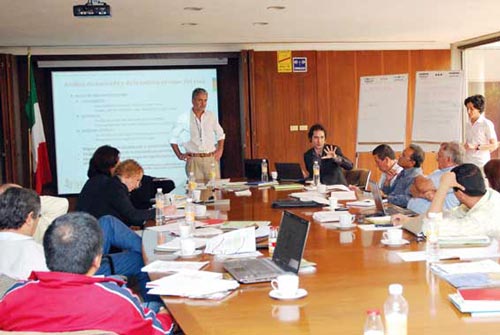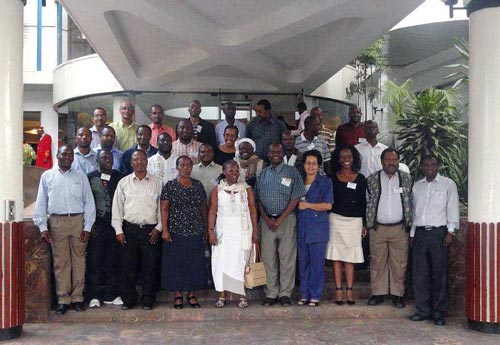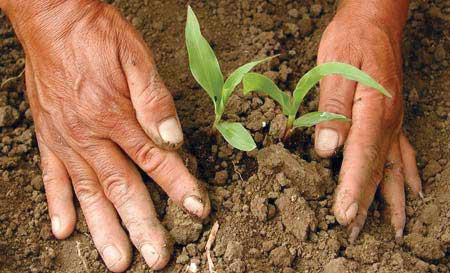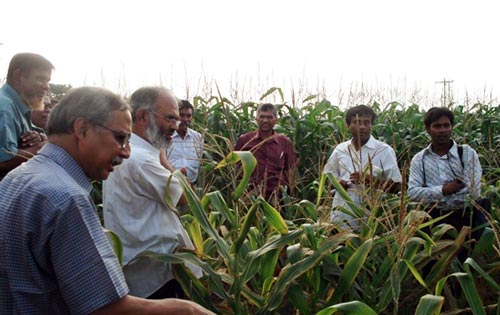Conservation agriculture trials impress in southern Ethiopia
In Hawassa region, southern Ethiopia, maize yields have been steadily declining. The deep-rooted agricultural practices of low farm input application and removal of crop residues to feed livestock have damaged the land: soil is eroded, nutrients and organic matter are depleted.
But change is afoot. In Ethiopia, the Sustainable intensification of maize-legume cropping systems for food security in eastern and southern Africa (SIMLESA) initiative is being implemented by the Ethiopian Institute of Agricultural Research (EIAR) and the Southern Agricultural Research Institute (SARI), with technical support from CIMMYT and financial assistance from the Australian Centre for International Agricultural Research (ACIAR). Last year, SIMLESA conducted on-farm trials using conservation agriculture (CA) techniques: minimum tillage, crop residue management, intercropping/crop rotation (with maize and haricot beans) and participatory variety selection trials.
One of the farmers taking part in the trials was Yohanes Gudeta. He planted four CA trial plots: sole maize (BH-543), sole haricot bean (rotation), sole maize (rotation) and maize intercropped with haricot bean. In comparing these with the trial plot he farmed using traditional techniques, Gudeta observed that “the maize under CA is very robust and green, an indication of far better yields than we usually harvest.” Next planting season, Gudeta plans to increase his area under CA from trial plots to 0.5 ha.
According to Dagne Wagery, SIMLESA National Coordinator for Ethiopia, the trials aim to demonstrate that practicing CA allows for enhanced productivity and profitability of maize and legumes, whilst decreasing production risks such as abiotic and biotic constraints. Gudeta agrees: “soil erosion is a big problem in this area considering that we have sandy soils. The plots under CA are not affected by soil erosion,” he said. Farmers participating in the trials have also found that CA is less labour intensive, largely due to the Roundup herbicide used in CA, which controls grasses as well as weeds.
The success of the trials encouraged EIAR and CIMMYT to organize a farmers’ field day to demonstrate the performance of CA technologies, which was held in the Hawassa Zuria district on 16 August. Farmers from the other SIMLESA districts of Meskan and Misrak Badawacho attended, alongside agriculture officers, developments agents, seed dealers, and researchers.
The visitors were impressed with the visible results of CA, especially in the aspect of intercropping maize and beans, as this provides additional crop yield from the same piece of land. “Obtaining additional yield, be it maize or beans from the same piece of land is a boost to food security and land use efficiency,” said Solomon Admassu , SIMLESA Hawassa Site Coordinator and organizer of the field day. Following the success of these trials, the stakeholders have pledged to increase the dissemination and adoption of CA for enhanced food security in Ethiopia.

 SIMLESA strengthens project monitoring and evaluation capacity. A Monitoring and Evaluation (M&E) Workshop was held in Nairobi, Kenya, during 13-17 June 2011 as part of the Sustainable Intensification of Maize-Legume cropping systems for food security in Eastern and Central Africa (SIMLESA) project. It was facilitated by a team from the Association for Strengthening Agricultural Research in Eastern and Central Africa (ASARECA) and led by Enock Warinda.
SIMLESA strengthens project monitoring and evaluation capacity. A Monitoring and Evaluation (M&E) Workshop was held in Nairobi, Kenya, during 13-17 June 2011 as part of the Sustainable Intensification of Maize-Legume cropping systems for food security in Eastern and Central Africa (SIMLESA) project. It was facilitated by a team from the Association for Strengthening Agricultural Research in Eastern and Central Africa (ASARECA) and led by Enock Warinda. A new era began this week with the launch of the CGIAR Research Program MAIZE, a US$170 million global alliance to expand and accelerate research into maize, on 06 July 2011. The announcement was made during a celebration of the CGIAR’s 40th birthday, held at the World Bank headquarters in Washington, marking a new direction for the CGIAR and demonstrating that after four remarkable decades it remains vigorous and committed to addressing emerging challenges.
A new era began this week with the launch of the CGIAR Research Program MAIZE, a US$170 million global alliance to expand and accelerate research into maize, on 06 July 2011. The announcement was made during a celebration of the CGIAR’s 40th birthday, held at the World Bank headquarters in Washington, marking a new direction for the CGIAR and demonstrating that after four remarkable decades it remains vigorous and committed to addressing emerging challenges. The Forum for Agricultural Research in Africa (FARA)
The Forum for Agricultural Research in Africa (FARA) Two CIMMYT-Mexico department heads, along with Mateo Vargas from Mexico’s Chapingo Autonomous University, traveled to Peru this July to lead a five-day training course on field data analysis, with an emphasis on maize. The course, coordinated by Luis Narro of CIMMYT-Colombia, ran from 19-23 July 2010 at the campus of
Two CIMMYT-Mexico department heads, along with Mateo Vargas from Mexico’s Chapingo Autonomous University, traveled to Peru this July to lead a five-day training course on field data analysis, with an emphasis on maize. The course, coordinated by Luis Narro of CIMMYT-Colombia, ran from 19-23 July 2010 at the campus of 
 History was in the making at El Batán last Friday, 30 July 2010. After months of training, studying, and practical application, four ASGROW technicians successfully completed a written and applied test on conservation agriculture (CA), achieving the first-ever CIMMYT-approved CA certifications. This was part of a CIMMYT-led initiative to disseminate CA in central Mexico. For three years CIMMYT has been partnering with SAGARPA-Fondo Borlaug, Fundación Produce Estado de México, and Monsanto to establish sustainable agriculture in the Mexico’s central highlands.
History was in the making at El Batán last Friday, 30 July 2010. After months of training, studying, and practical application, four ASGROW technicians successfully completed a written and applied test on conservation agriculture (CA), achieving the first-ever CIMMYT-approved CA certifications. This was part of a CIMMYT-led initiative to disseminate CA in central Mexico. For three years CIMMYT has been partnering with SAGARPA-Fondo Borlaug, Fundación Produce Estado de México, and Monsanto to establish sustainable agriculture in the Mexico’s central highlands. Various research and extensions workers collaborating with the project “Sustainable Intensification of Rice-Maize Systems in Bangladesh” organized five farmer field days throughout March and April 2010. The events took place in the districts of Comilla, Rangpur, and Rajshahi and attracted over 350 farmers.
Various research and extensions workers collaborating with the project “Sustainable Intensification of Rice-Maize Systems in Bangladesh” organized five farmer field days throughout March and April 2010. The events took place in the districts of Comilla, Rangpur, and Rajshahi and attracted over 350 farmers. Though the project, which started in November 2008, initially focused on adaptive research in farmers’ fields, it is now starting to emphasize dissemination of improved CA practicies and SSNM technologies to farmers as well. This will be done through training and capacity building with researchers, farmers, extension workers, machinery manufacturers, and service providers.
Though the project, which started in November 2008, initially focused on adaptive research in farmers’ fields, it is now starting to emphasize dissemination of improved CA practicies and SSNM technologies to farmers as well. This will be done through training and capacity building with researchers, farmers, extension workers, machinery manufacturers, and service providers.